An Almost-Total Lunar Eclipse
11/20/2021. Two nights back, I got perfect weather for an almost-total lunar eclipse and made a lot of work for myself using three of my favorite optics and three camera bodies in various combinations. It was an exceptionally beautiful eclipse and an exceptionally frantic effort to photograph it. I don't know quite how that happened.
First, here's what I think of as my "signature" photo for this event. Make it big. White space is not your friend for any photo on this page.
In fact, hell with it: just click on any still photo to see it presented properly.
Use your "back" button to come back here.
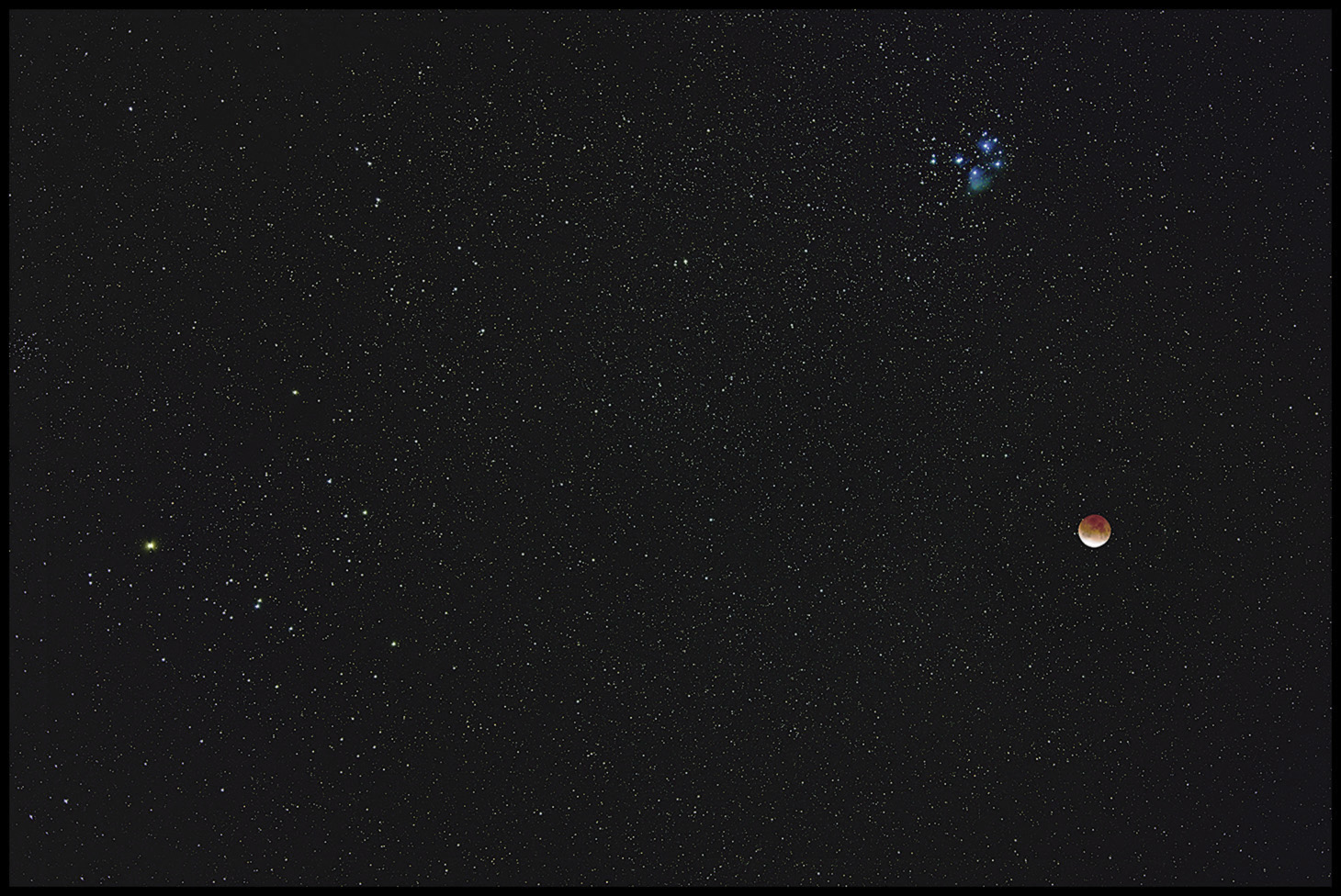
That's 85 ten-second exposures with the Sigma 105mm F1.4, stacked in PixInsight with the Moon layered in from a single 1/30-second exposure near centrality. Canon R6 at ISO 1600.
When stacking images, PixInsight can be instructed to reject pixels that are n standard deviations brighter or dimmer than the mean (it eliminates airplanes and satellites and fireflies and alien spacecraft). I looked at the pixels rejected for being too bright and discovered four satellite trails and two streaks that might be meteors. I went looking through the source and found the trails which did indeed display the typical variegated streak of meteors (high thin air smacked until it glows turns different colors as the meteor descends). Then I put together a second effort with just the two frames that had caught falling stars, kept the Pleiades from the full stack, and the Moon as before. The stars are actually cleaner and not much fainter (go figure). The Hyades are kinda lost. I should try restacking using separate RGB planes. I might get even cleaner results, but life is short and there's a lot to do.
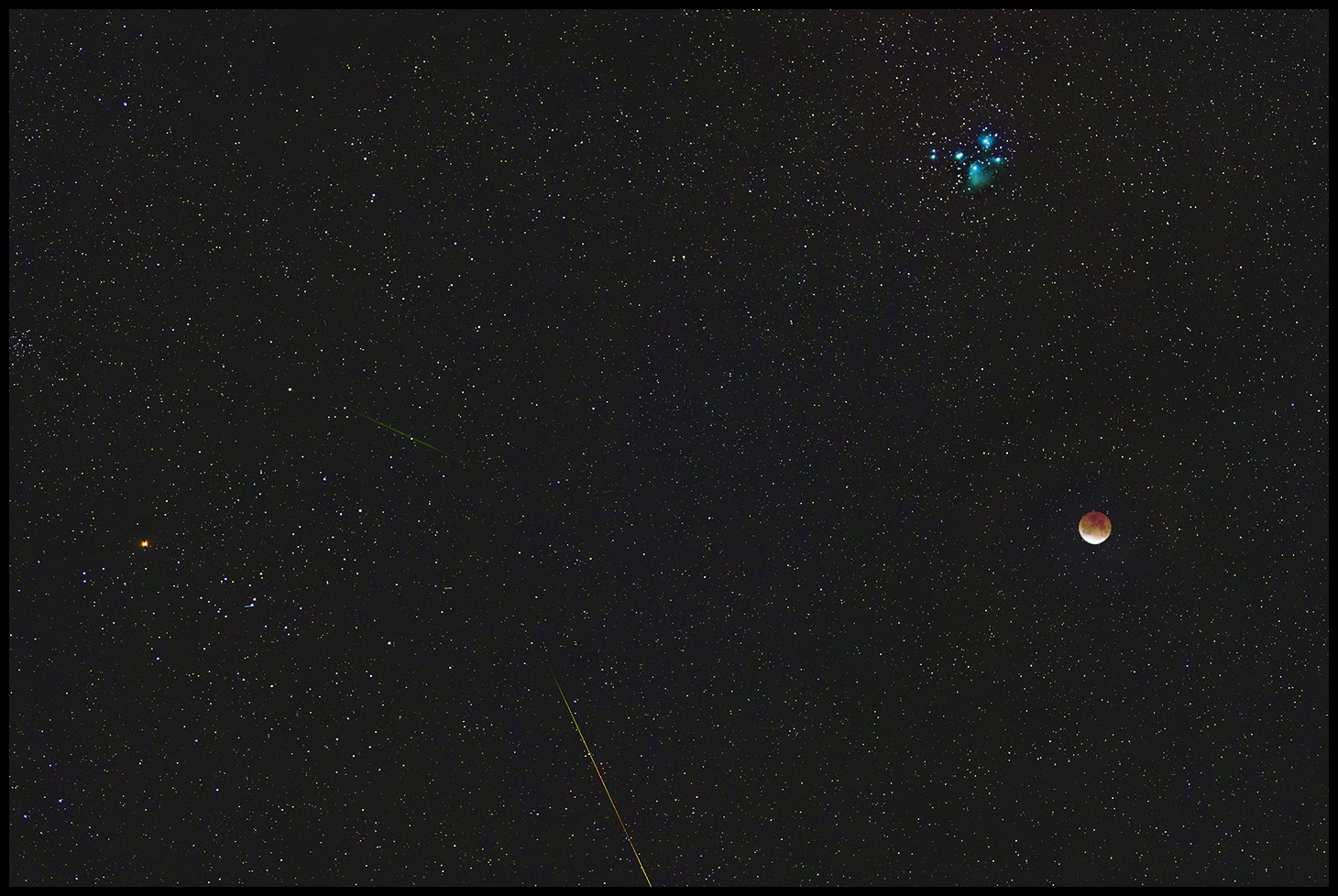
In both cases, a few stars in the vicinity of the Moon are bogus -- I couldn't control the glare quite well enough and just replaced a small bit of the sky with "plausible" stars. I'll work on that by and by, too.
Back to the beginning: I put the Canon 6D on a tripod and set an intervalometer to trigger 5-second exposures every 30 seconds. 24mm, F1.4, ISO 400, for hours.
I roughly polar aligned the Mach1 and plugged it into the new lithium power pack. I adore that mount! It stood there, solid as any fence post, tracking hour after hour while I assaulted it with different optical packages.
Throughout the eclipse, I swapped the 105mm Sigma on a D-plate for the TMB92SS. Behind the TMB92SS I usually used the Canon R6 with a TeleVue 0.8x flattener-compressor but near central eclipse, I mounted the ASI462MC with a TeleVue "Big Barlow" to try for details and color. That result was not as spectacular as I expected, in large part because the deep penumbra and outer umbra was decidedly grey, a steel-blue grey, but grey nonetheless. I got what it was. The color was not at all what I expected, but it seems pretty true to the eyepiece experience. (Psst: make it big.)
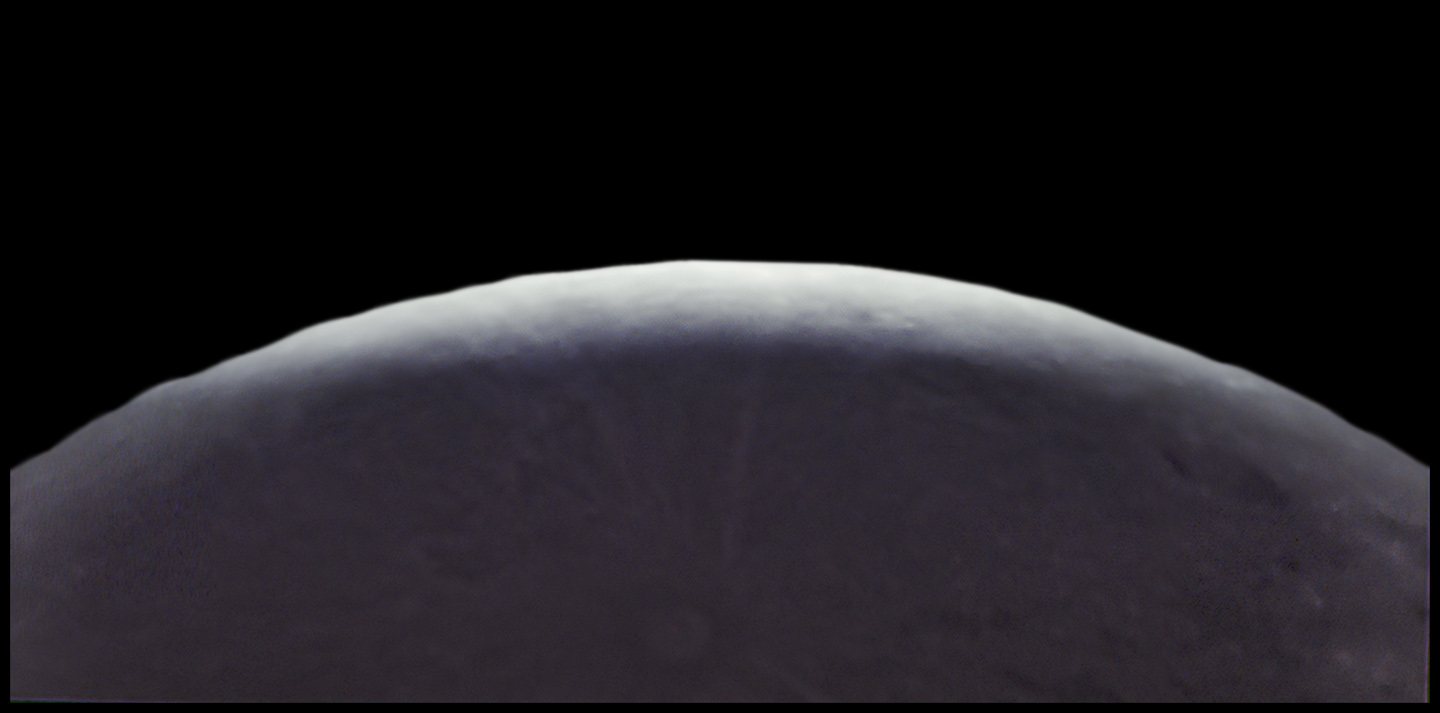
Best 150 of 5,000 frames.
I put the R6 back behind the TMB just a few minutes after deepest eclipse in order to do my level best to get an HDR of the eclipsed Moon amid its starfield. Exposuers were 1/250, 1/8, 1/4, and 1 second at ISO 800. See previous remarks about the hostility of white space: click the pix to see them well.
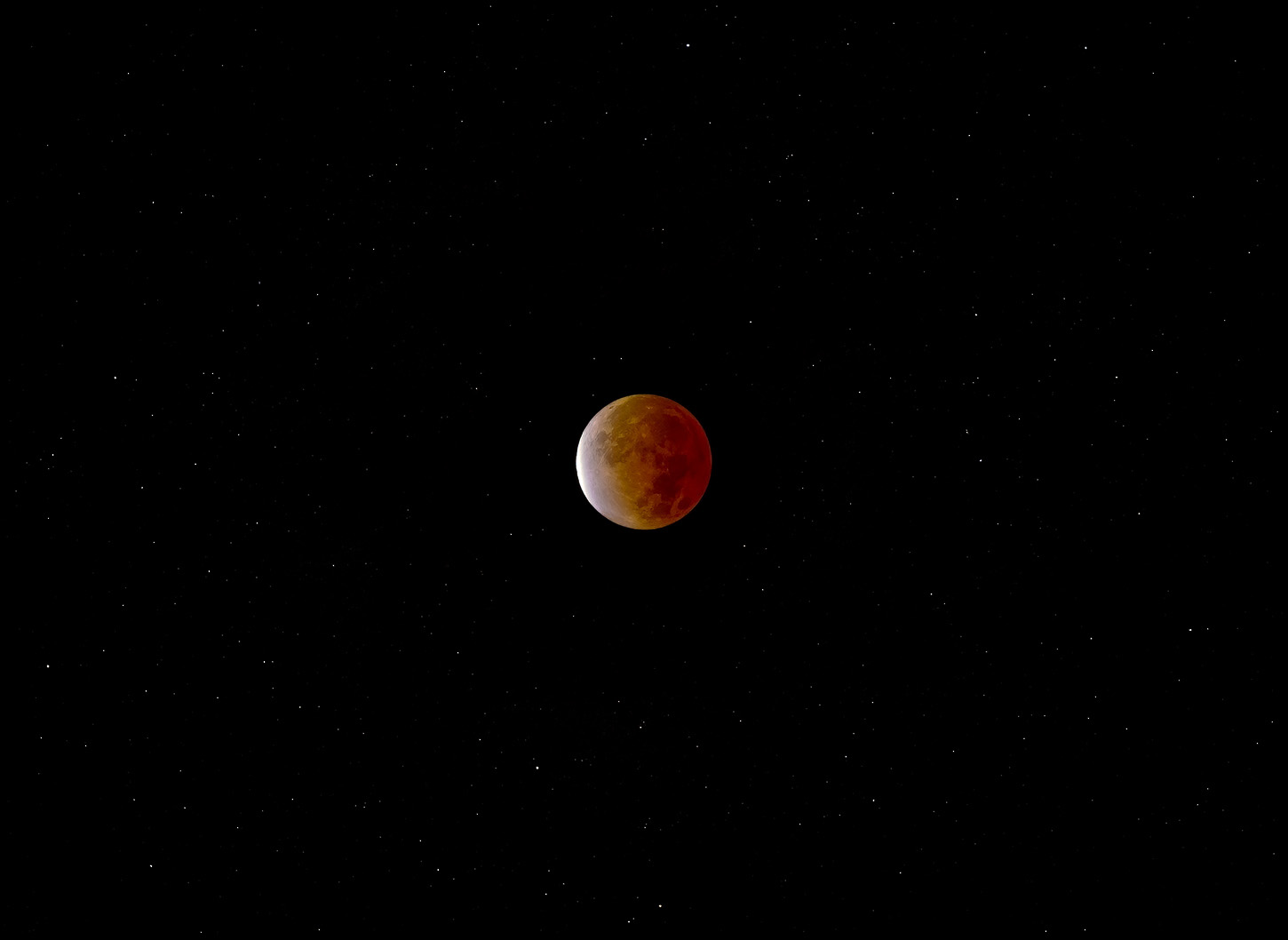
A closer look at the Moon...
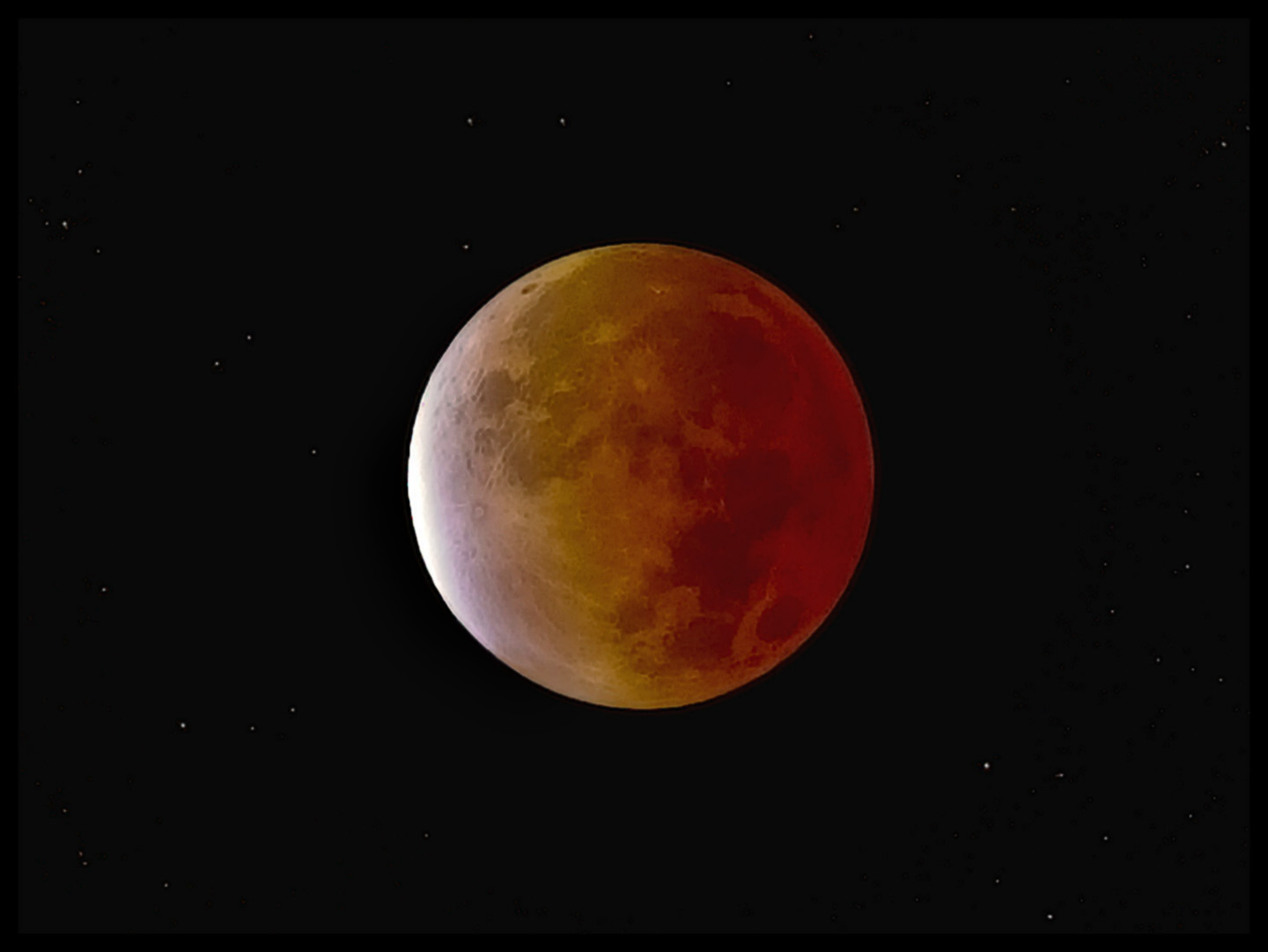
Then, as during the several minutes before the deepest eclipse, I remounted the 105mm to take the ten-second exposures that comprise the "signature" image(s) up above. I did this "manually," just repeatedly pressing the "take the picture" button on the R6's remote (see below).
These "Shadow of the Earth" photos became something of a cliche some years ago. I'm not sure when. (Here's a good start on an answer to that puzzle.) Photograph multiple phases of a lunar eclipse, align the photos on the background stars, and let the surface of the moving Moon form a screen against which the Earth's shadow is nicely projected. Thus:
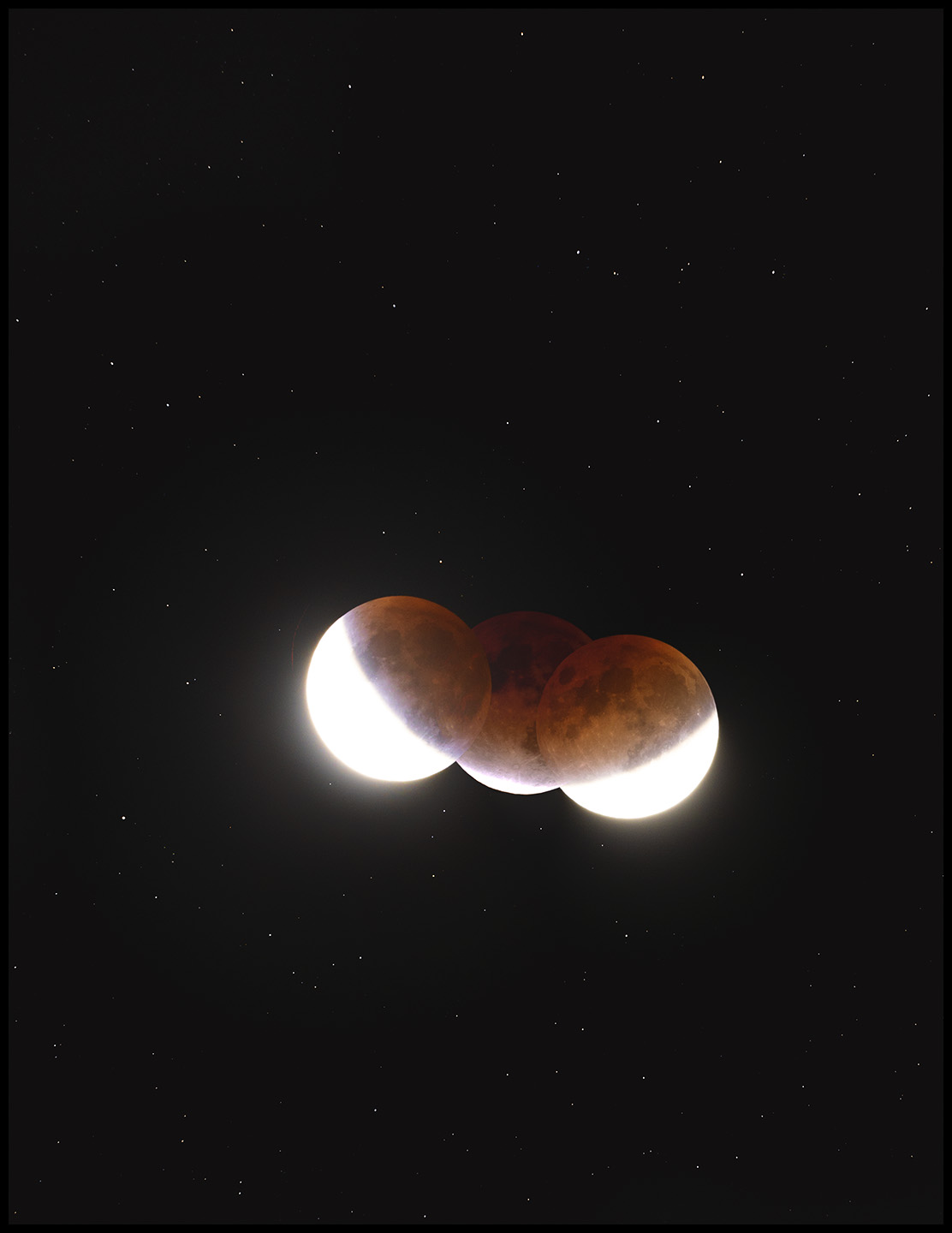
1/8, 1/4, 1/8 seconds plus 1 second for the starfield
Now, as to the misadventures of the evening. First, as I was loading gear, I noticed that the diaphram of the 24mm F1.4 had slipped again and made it a permanent F22 lens. That's useless. I've fixed it before, and it has twice failed to stay fixed. I considered: the only reason I own that lens is to use it at F1.4; speed is why it exists; that is why it is in my kit. At every other aperture, I have better, more convenient choices. I took the EOS mounting flange off, removed the diaphragm control ring, removed the next ring in (which was a step too far and turned out to be both unnecessary and troublesome) and unhooked the spring that keeps the diaphragm closed against mechanical levers and cams that hold it at various set apertures. As reassembled, it is now a 24mm F1.4 lens, ONLY an F1.4 lens. I may need to shim, glue, or otherwise lock the aperture in that open position, but absent the tension of the unfastened spring, it seems happy to stay where I left it. When IU had it back together, I checked to be sure the focal plane was still square to the camera sensor. It was not. That inner ring... I must have turned that internal mounting ring 90 degrees while putting things back together. I tore the lens down again, repositioned the ring, reshimmed, remeasured, and called it good enough. And that was an hour I did not have.
Shortly after arriving at the site ('twixt here and the Smith's house up above the cul de sac), I found that the R6's remote trigger had stayed home. Just the cable was attached to the camera, not the trigger. I started the 6D timelapse and then walked back to the house under the darkening Moon to find it or to get a spare. The trigger did not fall to hand and I found that all my spares were wired for the 6D, not for the R6 (Amazon will rectify that, but not tonight). I walked back in the dark, resigned to use the 2-second self-timer to release without vibration all the night's exposures longer than milliseconds. Then, tucked deep in my kit, I found a wireless controller for the R6 which had defeated me some months ago. What were my chances of getting it to work under the gun? The eclipsed Moon must have been inspirational; the release worked like a charm tonight (I'm lucky its batteries were lively). True, I didn't ask it to do very much, but it tripped the shutter on command and that was enough.
I thought the Moon would slide into the pines about an hour after central eclipse. It took much longer, and I wanted the time-lapse to end after it did so. That's OK, the brightening sky was dramatic, too. While killing time (an hour or more), I walked around the nearby roads, checked my phone, admired Jeremy Bevin's efforts behind his 8-inch reflector he had already posted to Facebook, and generally stayed warm sipping old coffee. Rick Kilpatrick ran by, said G'morning. On his return, I apologized for not hailing him first -- I thought I had imagined him! -- and we exchanged brief enthusiasms as he disappeared into the shadows whence cometh he. Then I went home and went to bed.
:: top ::
|